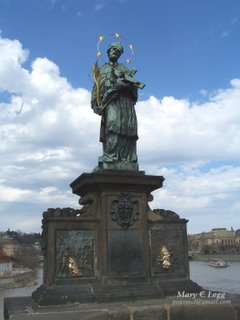

St John of Nepomuk
The statue of St John of Nepomuk was placed on Charles Bridge in 1683 in commemoration of his martydom under King Wenceslas IV on March 20, 1393. Popular legend of Prague and church lore has it that John of Nepomuk was thrown off the bridge for not disclosing the confessions of Queen Sofia of Bavaria-Wittelsbach by a jealous husband, Wenceslas the Drunkard. The story first appeared in the writings of the chronicler, Thomas Ebendorffer of Austria in the mid 15th century and then enlarged upon by a Jesuit, Balbinus of Prague, known as the Bohemian Pliny. Balbinus biography of John Nepomuk was refuted by the Jesuit order as being fabricated history, nontheless the story spread, resulting in official canonization of John Nepomuk under Benedict in 1683 in commemoration of his martydom under King Wenceslas IV on March 20, 1393. The first church dedicated to John Nepomuk was in Koniggratz in 1708 and 1719, the Pilgrimmage Church of St John Nepomuk was completed by the architect, Santini at Zdar nad Sazavou near Zelena Hora on the border between western Bohemia and Moravia. Today the church is listed as a Unesco's World Heritage site.
However, historical sources identify John of Nepomuk as Jan of Pomuk, the son of Wolflin who was educated in the newly established University of Prague for juriprudence and theology after which he studied Canon Law at the Univeristy of Padua. In 1374, he was appointed as first secretary to the Archbishop of Prague, John of Jenzenstein (jan of Jenstejn) and became a canon in the cathedral at Vysherhrad. In 1390, he became the Archdeacon of Sasz and also canon in the newly constructed cathedral of St Vitus at the Prague castle. The Archbishop John of Jenzenstein appointed him as his vicar-general because of his knowledge of civil and canon law.
Wenceslas, though, desired to accumulate power and wealth through establishing a new bishropy under his control through the Benedictine abbey at Kladrau which was flourishing and wealthy in lands and finances. The old abbott, Rarek, was about to die and Wenceslas wished to appoint someone whom he could control so that he would have the wealth and lands of the abbey at his disposal. The Archbishop instructed John of Nepomuk to warn the abbey to make immediate elections upon the abott's death, thereby thwarting the king's schemes. Incensed, the King arrested the vicar-general, the cathedral provost, Wenceslas of Meissen, the monk Odelenus and the archbishop's steward to have them interorrogated and tortured. John resisted torture and survived. He was gagged, put in a goatskin and dumped off the bridge into the river on March 20, 1393.
This account is documented from contemporaneous archives by the Archbishop and the newly-appointed abott of Kladrau. The body of ohn of Nepomuk was drwn from the river, Vltava (Moldau) and entombed in St. Vitus Cathedral. In later centuries, the stories becomes confused, arising with two Johns of Nepomuk, one serving as the Queen's confessor, however it is anachronistic confusion. The conflict between the two stories has been occassion for much dispute and controversy, particularly for attacks by detractors against the Catholic Church as John of Nepomuk is discounted as being a bad copy of Jan Hus. The error here should be immediately apparent as Jan Hus lived between 1369-1415 and John of Nepomuk was tortured and drowned in 1393. Wenceslas the Drunkard tried to potect Hus as he saw the danger of angry insurrection from his followers. Hus was excommunicated in 1411, Hus was burned at stake in Constance on July 6, 1415.
May 16 is the feast day of St John Nepomuk which is celebrated by a joint vesper sevice with the church of St. Thomas, OSA, and the Church of the Red Cross with a Star, the Church of St Francis directly on the river bank on the inner city of Prague. The Knights of the Order of the Red Cross with a Star were established by St Agnes Premyslide after Fransciscan idealism around 1233 in Prague. The Knights were officially recognized by the Vatican in 1237. St Agnes Premyslide was a daughter of Premysl Otakar I, living between 1211 and 1282. The baroque church, built between 1679-1688 by Jean B. Mathey, stands where the order had maintained its presence since it founding in 1252 as Hospilaters in Prague. After vespers, the two congregations make a solemn procession across the bridge and stop at the statue of St John Nepomuk to commemorate his martyrdom. Local legend states that if your prayer will be answered if you place your hands on the plate by the statue of St. John.
Links:
Wikipedia: John Nepomuk
http://en.wikipedia.org/wiki/John_Nepomuk
Answers.com John of Nepomuk
http://www.answers.com/topic/john-of-nepomuk
Catholic Encyclopedia
http://www.newadvent.org/cathen/08467a.htm
Wenceslas IV
http://tinyurl.com/p5rrz
Pilgrimmage Church of John of Nepomuk
http://www.worldheritagesite.org/sites/stjohnofnepomuk.html
Pilgrimage Church of St. John of Nepomuk at Zelena Hora" was added to Unesco's World Heritage List in 1994
Order of the Knightts with the Red Star
http://www.smom-za.org/bgt/redstar.htm



0 Comments:
Post a Comment
<< Home